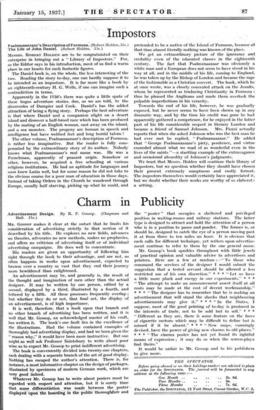Charm in Publicity
Mn. GosSoP makes it clear at the outset that he limits his consideration of advertising strictly to that section of it described by his title. He explores no new fields, advances no theories, advocates no new methods, makes no prophecies, and offers no criticism of advertising itself or of individual advertising campaigns. He does well to concentrate.
His readers are given an opportunity of following him right through the book to their advantage, and are not, as often happens in works upon advertisement, expected to browse over a country so vast that they end their journey more bewildered than enlightened.
An advertisement may be, and generally is, the result of the thought and imagination of men other than the actual designer. It may be written by one person, edited by a second, displayed by a third, illustrated by a fourth, and lettered by a fifth. All these processes frequently overlap ; but whether they do or not, that final act, the display of an advertisement, is of high importance.
It is well, therefore, that a book upon that branch and no other branch of advertising has been written, and it is well that Mr. Gossop, an acknowledged master of his craft, has written it. The book's one fault lies in the excellence of the illustrations. Had the volume contained examples of thoroughly bad advertising display, and had we been given the " reason why," it would have been more instructive.. But one might as well ask Professor Saintsbury to write about poor wine as to expect Mr. GossOp to print indifferent advertising.
The book is conveniently divided into twenty-one chapters, each dealing with a separate branch of the art of good display. Nothing has escaped the author's attention. There is, for instance, a most informative chapter on the design of packages, illustrated by specimens of modern German work, which are very good indeed.
Whatever Mr. Gossop has to write about posters must be regarded with respect and attention, but it is surely time that some differentiation was made between the poster displayed upon the hotiiding in the public thoroughfare and the " poster " that occupies a sheltered and privileged position in waiting-rooms and railway stations. The latter type is designed to attract and hold the attention of a person who is in a position to pause and ponder. The former is, or should be, designed to catch the eye of a person moving past it at from three to ten miles an hour. It is obvious that each calls for different technique, yet writers upon advertise- ment continue to refer to them by the one general name.
Mr. Gossop's book sparkles throughout with little jewels of practical opinion and valuable advice to advertisers and printers. Here are a few at random :—" To those who command the services of the designer I would submit the suggestion that a tested servant should be allowed a less restricted use of his own discretion." * * * " Let us have a little more pluck and energy in our experiments." * * * " The attempt to make an announcement assert itself at all costs may be made at the cost of decent workmanship."
* * * " The designer has to remember that he is making an advertisement that will stand the shocks that neighbouring advertisements may give it." * * * " In the States, I suppose, most of the good printing of to-day is produced in the interests of trade, not to be sold but to sell." * * * " Different as they are, there is some feature on the faces of cigarette cartons which may be difficult to define but is missed if it be absent." * * * " New maps, cunningly devised, have the power of giving new charms to old places."
* * * " The cinema poster has not yet found its rightful means of expression ; it may do so when the screen-plays find theirs."
It would be unfair to Mr. Gossop and to his publishers to give more.


































 Previous page
Previous page